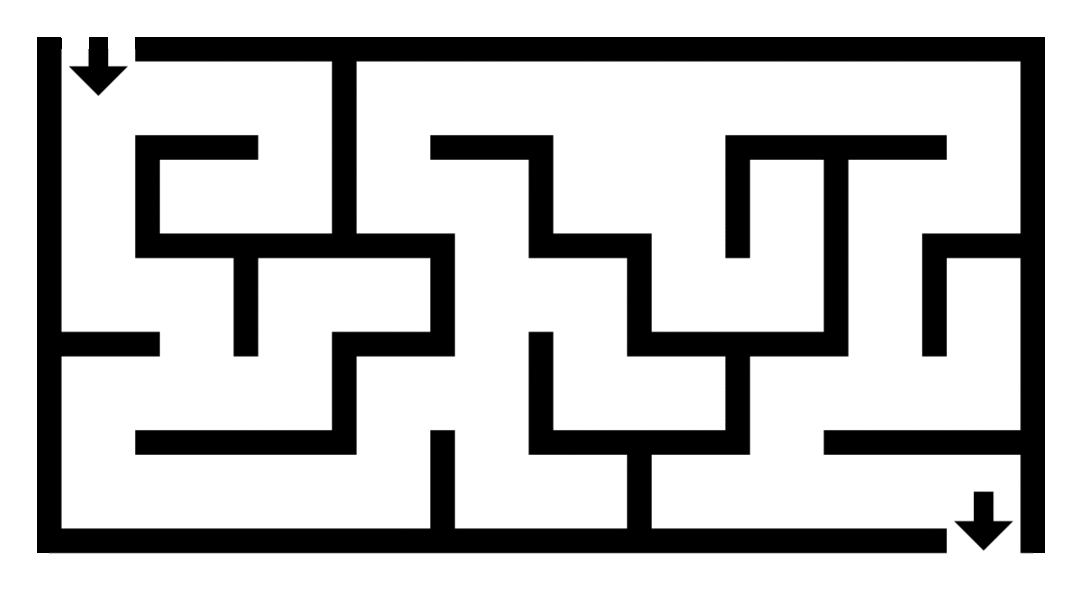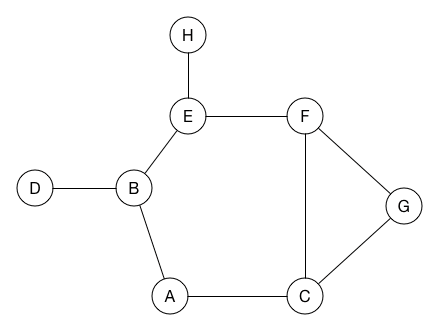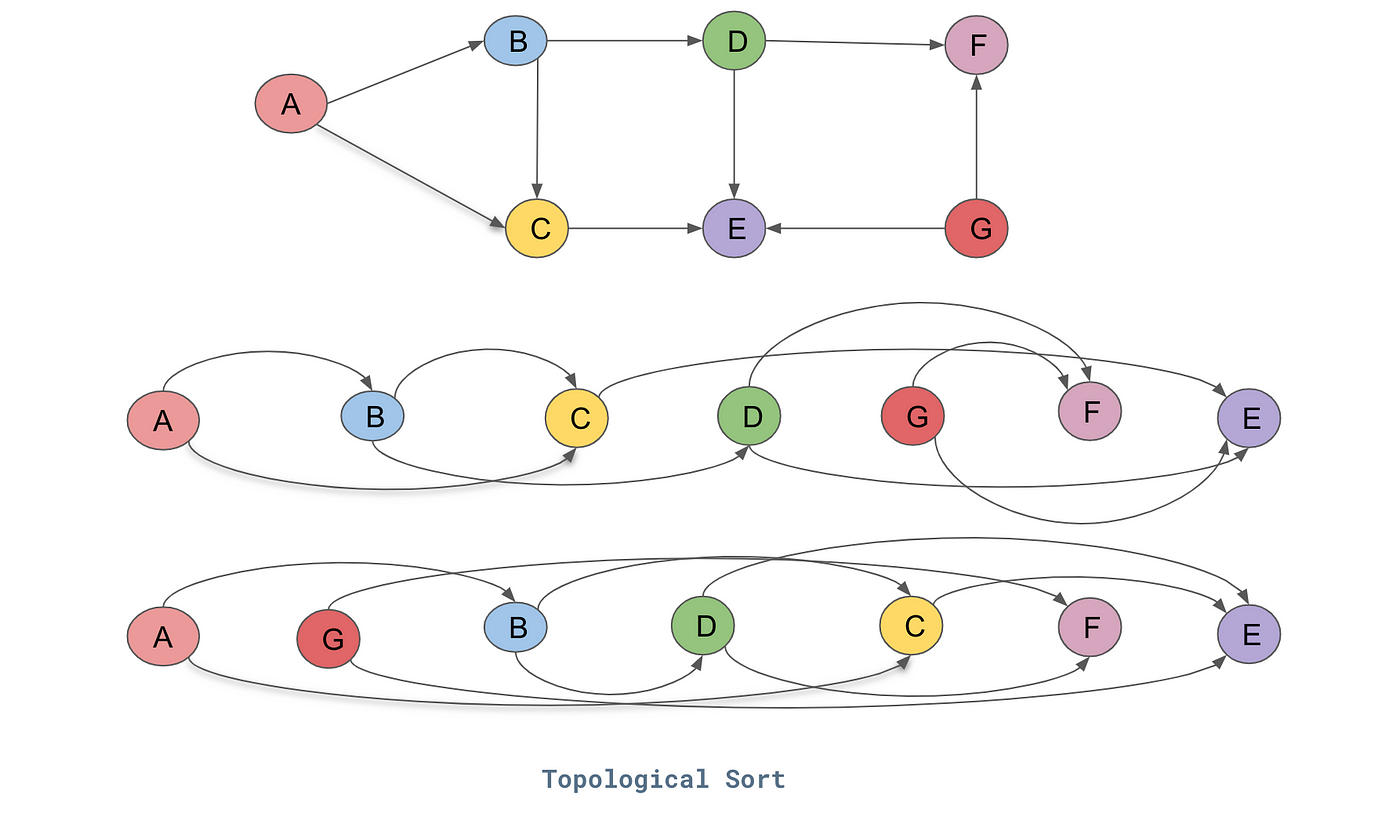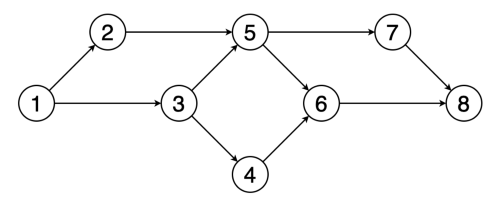# Graph Traversals ## and Topological Sort --- CS 137 // 2021-10-25 <!--=====================================================================--> ## Administrivia - Assignment 2 is due on Wednesday + Let me know if you need an extension - <!-- .element: class="fragment"--> DE6 returned on Gradescope - <!-- .element: class="fragment"--> If you haven't already, please fill out the [midterm evaluation questionnaire](https://docs.google.com/forms/d/e/1FAIpQLSeWe6Nd0ndk-XsfXjH9a3_B9lsRtY6yQFUtPltsXj8n2OoirA/viewform?usp=sf_link) + Need to be signed into Google with your Drake email address <!--=====================================================================--> # Questions ## ...about anything? <!----------------------------------> <!-- .slide: data-background-iframe="/teaching/2021f/cs137/assignments/assignment-2/" data-background-interactive --> <!--=====================================================================--> # Maze Solving <!-- .slide: data-background="#004477" --> <!--=====================================================================--> ## Maze Solving  <!--=====================================================================--> ## Mazes are Just Graphs - Note that a maze can be modeled as a graph - Every "room" is a vertex and every "door" is an edge - Thus, maze solving is equivalent to searching through the paths of a graph <!--=====================================================================--> ## Graph Adjacency List <div class='jekyll-diagrams diagrams graphviz'> <!-- Generated by graphviz version 2.43.0 (0) --> <!-- Title: %3 Pages: 1 --> <svg width="332pt" height="162pt" viewBox="0.00 0.00 332.00 161.53" xmlns="http://www.w3.org/2000/svg" xmlns:xlink="http://www.w3.org/1999/xlink"> <g id="graph0" class="graph" transform="scale(1 1) rotate(0) translate(4 157.53)"> <title>%3</title> <polygon fill="white" stroke="transparent" points="-4,4 -4,-157.53 328,-157.53 328,4 -4,4"/> <!-- a --> <g id="node1" class="node"> <title>a</title> <ellipse fill="none" stroke="black" cx="27" cy="-89.53" rx="27" ry="18"/> <text text-anchor="middle" x="27" y="-85.83" font-family="Times,serif" font-size="14.00">a</text> </g> <!-- b --> <g id="node2" class="node"> <title>b</title> <ellipse fill="none" stroke="black" cx="117" cy="-135.53" rx="27" ry="18"/> <text text-anchor="middle" x="117" y="-131.83" font-family="Times,serif" font-size="14.00">b</text> </g> <!-- a->b --> <g id="edge1" class="edge"> <title>a->b</title> <path fill="none" stroke="black" d="M48.85,-100.43C60.03,-106.27 74,-113.57 86.29,-120"/> <polygon fill="black" stroke="black" points="84.81,-123.17 95.29,-124.7 88.05,-116.97 84.81,-123.17"/> </g> <!-- c --> <g id="node3" class="node"> <title>c</title> <ellipse fill="none" stroke="black" cx="207" cy="-66.53" rx="27" ry="18"/> <text text-anchor="middle" x="207" y="-62.83" font-family="Times,serif" font-size="14.00">c</text> </g> <!-- a->c --> <g id="edge3" class="edge"> <title>a->c</title> <path fill="none" stroke="black" d="M53.88,-86.18C84.55,-82.22 135.83,-75.59 170.27,-71.14"/> <polygon fill="black" stroke="black" points="170.91,-74.59 180.37,-69.84 170.01,-67.65 170.91,-74.59"/> </g> <!-- b->c --> <g id="edge2" class="edge"> <title>b->c</title> <path fill="none" stroke="black" d="M135.39,-121.89C148.28,-111.78 166.07,-97.84 180.56,-86.47"/> <polygon fill="black" stroke="black" points="182.94,-89.05 188.65,-80.13 178.62,-83.55 182.94,-89.05"/> </g> <!-- e --> <g id="node5" class="node"> <title>e</title> <ellipse fill="none" stroke="black" cx="297" cy="-20.53" rx="27" ry="18"/> <text text-anchor="middle" x="297" y="-16.83" font-family="Times,serif" font-size="14.00">e</text> </g> <!-- c->e --> <g id="edge5" class="edge"> <title>c->e</title> <path fill="none" stroke="black" d="M228.85,-55.62C240.03,-49.78 254,-42.48 266.29,-36.05"/> <polygon fill="black" stroke="black" points="268.05,-39.08 275.29,-31.35 264.81,-32.88 268.05,-39.08"/> </g> <!-- d --> <g id="node4" class="node"> <title>d</title> <ellipse fill="none" stroke="black" cx="117" cy="-43.53" rx="27" ry="18"/> <text text-anchor="middle" x="117" y="-39.83" font-family="Times,serif" font-size="14.00">d</text> </g> <!-- d->c --> <g id="edge4" class="edge"> <title>d->c</title> <path fill="none" stroke="black" d="M142.51,-49.93C151.57,-52.3 162.01,-55.03 171.78,-57.58"/> <polygon fill="black" stroke="black" points="171.06,-61.01 181.62,-60.15 172.83,-54.24 171.06,-61.01"/> </g> <!-- e->a --> <g id="edge6" class="edge"> <title>e->a</title> <path fill="none" stroke="black" d="M271.76,-13.52C231.77,-3.36 150.38,11.41 90,-16.53 69.12,-26.19 52.7,-46.73 42.01,-63.57"/> <polygon fill="black" stroke="black" points="38.83,-62.08 36.68,-72.45 44.83,-65.68 38.83,-62.08"/> </g> </g> </svg> </div> ```py # Represents a graph as a dictionary (hashtable) that maps # vertices to a list of neighbors (i.e. adjacency list) test_graph = { "a" : ["b","c"], "b" : ["c"], "d" : ["c"], "c" : ["e"], "e" : ["a"] } test_graph["a"] # gets the neighbors of "a" ``` <!--=====================================================================--> # Depth-First Search (DFS) <!-- .slide: data-background="#004477" --> <!--=====================================================================--> ## Depth-First Search - Core idea: + Maintain a **set** of vertices we've seen already + Maintain a **stack** of vertices we've discovered but haven't processed yet + Repeatedly pop a vertex off the stack, push each unvisited neighbor to the stack and seen vertices <!----------------------------------> ## DFS Visualization  <!----------------------------------> ## DFS Pseudocode ```text dfs(g, start) Initialize set D = {start} Initialize stack S = (start) While S is not empty Let u = S.pop() Process the vertex u For each vertex, v, neighboring u If v is not in D Add v to D Push v to S ``` <!----------------------------------> ## DFS Implementation ```py def dfs(g, start): discovered = {start} stack = [start] while len(stack) > 0: u = stack.pop() print(u) for v in g[u]: if v not in discovered: discovered.add(v) stack.append(v) ``` - <!-- .element: class="fragment"--> Given a graph with $n$ vertices and $m$ edges, what is the runtime complexity of DFS? - <!-- .element: class="fragment"--> $O(n + m)$, (each vertex/edge is touched once) - <!-- .element: class="fragment"--> This is the "linear time" for graphs <!--=====================================================================--> ## Using DFS to Solve Problems - Many graph problems reduce to a traversal like DFS - <!-- .element: class="fragment"--> How can we use DFS to solve mazes? <!--=====================================================================--> ## Keeping Track of Paths - It is possible to modify DFS in order to remember the path taken from the starting vertex - <!-- .element: class="fragment"--> Need to remember the **parent** of discovered vertices ```py[2,12] def dfs(g, start): parents = {start : None} discovered = {start} stack = [start] while len(stack) > 0: u = stack.pop() print(u) for v in g[u]: if v not in discovered: discovered.add(v) stack.append(v) parents[v] = u ``` <!-- .element: class="fragment"--> <!----------------------------------> ## Reconstructing Path - Given `parents`, how can we reconstruct the path from `start` to a target vertex `end`? ```py def construct_path(parents, start, end): if end not in parents: # end isn't reachable return None elif start == end: return [start] else: prev = parents[end] path = construct_path(parents, start, prev) path.append(end) return path ``` <!-- .element: class="fragment"--> <!--=====================================================================--> ## Solving a Maze - We now have what we need to solve general mazes: ```py def solve_maze(g, start, end): parents = {start : None} discovered = {start} stack = [start] while len(stack) > 0: u = stack.pop() for v in g[u]: if v not in discovered: discovered.add(v) stack.append(v) parents[v] = u return construct_path(parents, start, end) ``` - <!-- .element: class="fragment"--> Does this algorithm always return the shortest path? + <!-- .element: class="fragment"--> No. Will return first path found even if long <!--=====================================================================--> ## Finding the Shortest Path - For shortest path, we need another approach - <!-- .element: class="fragment"--> Note that with DFS we always process the most recently discovered vertex + <!-- .element: class="fragment"--> This causes us to go "deep" down a path and only turn around when we find a dead end - <!-- .element: class="fragment"--> What if we process the vertices in a different order? <!---------------------------------->  <!--=====================================================================--> # Breadth-First Search (BFS) <!-- .slide: data-background="#004477" --> <!--=====================================================================--> ## Breadth-First Search (BFS) - The core idea behind BFS is the same as DFS except we process the vertices in a different order - <!-- .element: class="fragment"--> Instead of processing the last discovered vertex, we will process vertices in the order we find them + <!-- .element: class="fragment"--> Instead of a "last in first out" we want a "first in first out" ordering <!----------------------------------> ## BFS Implementation ```py[1-12|5,12] from collections import deque def bfs(g, start): discovered = {start} queue = deque(discovered) while len(queue) > 0: u = queue.pop() print(u) for v in g[u]: if v not in discovered: discovered.add(v) queue.appendleft(v) ``` <!----------------------------------> ## DFS and BFS Visualization  <!--=====================================================================--> ## Exercise - BFS can be used to find the shortest path **from** a vertex $u$ to every other reachable vertex in the graph - <!-- .element: class="fragment"--> Suppose we want to do something similar: + Find the shortest path **to** a vertex $u$ from every other vertex in the graph - <!-- .element: class="fragment"--> With your table, come up with an algorithm for this + No need to write code---just the idea <!--=====================================================================--> ## Exercise - A directed graph is **strongly connected** if for every pair of vertices, $u,v$, there is a path starting at $u$ and ending at $v$ - <!-- .element: class="fragment"--> With your table, come up with an algorithm for this + No need to write code---just the idea <!--=====================================================================--> # Topological Sort <!-- .slide: data-background="#004477" --> <!--=====================================================================--> ## Prerequisite Graphs - An issue you might be familiar with is writing a schedule to take all the CS requirements in some particular order (four year plan) --- <div class='jekyll-diagrams diagrams graphviz'> <!-- Generated by graphviz version 2.43.0 (0) --> <!-- Title: %3 Pages: 1 --> <svg width="486pt" height="268pt" viewBox="0.00 0.00 486.00 268.00" xmlns="http://www.w3.org/2000/svg" xmlns:xlink="http://www.w3.org/1999/xlink"> <g id="graph0" class="graph" transform="scale(1 1) rotate(0) translate(4 264)"> <title>%3</title> <polygon fill="white" stroke="transparent" points="-4,4 -4,-264 482,-264 482,4 -4,4"/> <!-- cs147 --> <g id="node1" class="node"> <title>cs147</title> <polygon fill="none" stroke="black" points="166,-112 86,-112 86,-74 166,-74 166,-112"/> <text text-anchor="middle" x="126" y="-96.8" font-family="Times,serif" font-size="14.00">CS 147</text> <text text-anchor="middle" x="126" y="-81.8" font-family="Times,serif" font-size="14.00">Graphics</text> </g> <!-- cs167 --> <g id="node2" class="node"> <title>cs167</title> <polygon fill="none" stroke="black" points="286,-186 176,-186 176,-148 286,-148 286,-186"/> <text text-anchor="middle" x="231" y="-170.8" font-family="Times,serif" font-size="14.00">CS 167</text> <text text-anchor="middle" x="231" y="-155.8" font-family="Times,serif" font-size="14.00">Mach. Learn.</text> </g> <!-- cs178 --> <g id="node3" class="node"> <title>cs178</title> <polygon fill="none" stroke="black" points="252,-112 184,-112 184,-74 252,-74 252,-112"/> <text text-anchor="middle" x="218" y="-96.8" font-family="Times,serif" font-size="14.00">CS 178</text> <text text-anchor="middle" x="218" y="-81.8" font-family="Times,serif" font-size="14.00">Cloud</text> </g> <!-- cs65 --> <g id="node4" class="node"> <title>cs65</title> <polygon fill="lightblue" stroke="lightblue" points="260.5,-260 201.5,-260 201.5,-222 260.5,-222 260.5,-260"/> <text text-anchor="middle" x="231" y="-244.8" font-family="Times,serif" font-size="14.00">CS 65</text> <text text-anchor="middle" x="231" y="-229.8" font-family="Times,serif" font-size="14.00">CS I</text> </g> <!-- cs65->cs167 --> <g id="edge1" class="edge"> <title>cs65->cs167</title> <path fill="none" stroke="black" d="M231,-221.83C231,-214.13 231,-204.97 231,-196.42"/> <polygon fill="black" stroke="black" points="234.5,-196.41 231,-186.41 227.5,-196.41 234.5,-196.41"/> </g> <!-- cs66 --> <g id="node5" class="node"> <title>cs66</title> <polygon fill="lightblue" stroke="lightblue" points="157.5,-186 98.5,-186 98.5,-148 157.5,-148 157.5,-186"/> <text text-anchor="middle" x="128" y="-170.8" font-family="Times,serif" font-size="14.00">CS 66</text> <text text-anchor="middle" x="128" y="-155.8" font-family="Times,serif" font-size="14.00">CS II</text> </g> <!-- cs65->cs66 --> <g id="edge2" class="edge"> <title>cs65->cs66</title> <path fill="none" stroke="black" d="M205.01,-221.83C192.08,-212.79 176.28,-201.75 162.36,-192.02"/> <polygon fill="black" stroke="black" points="164.18,-189.02 153.98,-186.16 160.17,-194.76 164.18,-189.02"/> </g> <!-- cs139 --> <g id="node13" class="node"> <title>cs139</title> <polygon fill="lightseagreen" stroke="lightseagreen" points="372,-186 304,-186 304,-148 372,-148 372,-186"/> <text text-anchor="middle" x="338" y="-170.8" font-family="Times,serif" font-size="14.00">CS 139</text> <text text-anchor="middle" x="338" y="-155.8" font-family="Times,serif" font-size="14.00">Theory</text> </g> <!-- cs65->cs139 --> <g id="edge3" class="edge"> <title>cs65->cs139</title> <path fill="none" stroke="black" d="M258,-221.83C271.43,-212.79 287.85,-201.75 302.3,-192.02"/> <polygon fill="black" stroke="black" points="304.67,-194.65 311.01,-186.16 300.76,-188.84 304.67,-194.65"/> </g> <!-- cs66->cs147 --> <g id="edge4" class="edge"> <title>cs66->cs147</title> <path fill="none" stroke="black" d="M127.5,-147.83C127.28,-140.13 127.03,-130.97 126.79,-122.42"/> <polygon fill="black" stroke="black" points="130.29,-122.31 126.51,-112.41 123.29,-122.51 130.29,-122.31"/> </g> <!-- cs66->cs178 --> <g id="edge5" class="edge"> <title>cs66->cs178</title> <path fill="none" stroke="black" d="M150.71,-147.83C161.8,-138.96 175.3,-128.16 187.29,-118.57"/> <polygon fill="black" stroke="black" points="189.67,-121.14 195.3,-112.16 185.3,-115.68 189.67,-121.14"/> </g> <!-- cs146 --> <g id="node6" class="node"> <title>cs146</title> <polygon fill="lightblue" stroke="lightblue" points="329.5,-112 270.5,-112 270.5,-74 329.5,-74 329.5,-112"/> <text text-anchor="middle" x="300" y="-96.8" font-family="Times,serif" font-size="14.00">CS 67</text> <text text-anchor="middle" x="300" y="-81.8" font-family="Times,serif" font-size="14.00">CS III</text> </g> <!-- cs66->cs146 --> <g id="edge6" class="edge"> <title>cs66->cs146</title> <path fill="none" stroke="black" d="M157.72,-152.04C160.84,-150.64 163.98,-149.27 167,-148 208.22,-130.62 219.78,-129.38 261,-112 261.09,-111.96 261.19,-111.92 261.28,-111.88"/> <polygon fill="black" stroke="black" points="262.51,-115.16 270.28,-107.96 259.71,-108.75 262.51,-115.16"/> </g> <!-- cs130 --> <g id="node7" class="node"> <title>cs130</title> <polygon fill="lightblue" stroke="lightblue" points="68,-112 0,-112 0,-74 68,-74 68,-112"/> <text text-anchor="middle" x="34" y="-96.8" font-family="Times,serif" font-size="14.00">CS 130</text> <text text-anchor="middle" x="34" y="-81.8" font-family="Times,serif" font-size="14.00">Org I</text> </g> <!-- cs66->cs130 --> <g id="edge7" class="edge"> <title>cs66->cs130</title> <path fill="none" stroke="black" d="M104.28,-147.83C92.59,-138.88 78.33,-127.96 65.72,-118.3"/> <polygon fill="black" stroke="black" points="67.78,-115.47 57.71,-112.16 63.52,-121.02 67.78,-115.47"/> </g> <!-- cs135 --> <g id="node8" class="node"> <title>cs135</title> <polygon fill="lightblue" stroke="lightblue" points="334,-38 266,-38 266,0 334,0 334,-38"/> <text text-anchor="middle" x="300" y="-22.8" font-family="Times,serif" font-size="14.00">CS 135</text> <text text-anchor="middle" x="300" y="-7.8" font-family="Times,serif" font-size="14.00">PL</text> </g> <!-- cs146->cs135 --> <g id="edge8" class="edge"> <title>cs146->cs135</title> <path fill="none" stroke="black" d="M300,-73.83C300,-66.13 300,-56.97 300,-48.42"/> <polygon fill="black" stroke="black" points="303.5,-48.41 300,-38.41 296.5,-48.41 303.5,-48.41"/> </g> <!-- cs137 --> <g id="node9" class="node"> <title>cs137</title> <polygon fill="lightblue" stroke="lightblue" points="447.5,-38 352.5,-38 352.5,0 447.5,0 447.5,-38"/> <text text-anchor="middle" x="400" y="-22.8" font-family="Times,serif" font-size="14.00">CS 137</text> <text text-anchor="middle" x="400" y="-7.8" font-family="Times,serif" font-size="14.00">Algorithms</text> </g> <!-- cs146->cs137 --> <g id="edge9" class="edge"> <title>cs146->cs137</title> <path fill="none" stroke="black" d="M325.23,-73.83C337.79,-64.79 353.13,-53.75 366.64,-44.02"/> <polygon fill="black" stroke="black" points="368.7,-46.85 374.77,-38.16 364.61,-41.17 368.7,-46.85"/> </g> <!-- cs188 --> <g id="node12" class="node"> <title>cs188</title> <polygon fill="lightblue" stroke="lightblue" points="248,-38 180,-38 180,0 248,0 248,-38"/> <text text-anchor="middle" x="214" y="-22.8" font-family="Times,serif" font-size="14.00">CS 188</text> <text text-anchor="middle" x="214" y="-7.8" font-family="Times,serif" font-size="14.00">SE</text> </g> <!-- cs146->cs188 --> <g id="edge10" class="edge"> <title>cs146->cs188</title> <path fill="none" stroke="black" d="M278.3,-73.83C267.81,-65.05 255.05,-54.37 243.68,-44.85"/> <polygon fill="black" stroke="black" points="245.61,-41.9 235.69,-38.16 241.12,-47.27 245.61,-41.9"/> </g> <!-- math54 --> <g id="node10" class="node"> <title>math54</title> <polygon fill="lightblue" stroke="lightblue" points="397.5,-260 278.5,-260 278.5,-222 397.5,-222 397.5,-260"/> <text text-anchor="middle" x="338" y="-244.8" font-family="Times,serif" font-size="14.00">MATH 54</text> <text text-anchor="middle" x="338" y="-229.8" font-family="Times,serif" font-size="14.00">Discrete Math</text> </g> <!-- math54->cs167 --> <g id="edge11" class="edge"> <title>math54->cs167</title> <path fill="none" stroke="black" d="M311,-221.83C297.57,-212.79 281.15,-201.75 266.7,-192.02"/> <polygon fill="black" stroke="black" points="268.24,-188.84 257.99,-186.16 264.33,-194.65 268.24,-188.84"/> </g> <!-- math54->cs137 --> <g id="edge12" class="edge"> <title>math54->cs137</title> <path fill="none" stroke="black" d="M356.85,-221.72C365.7,-211.98 375.49,-199.28 381,-186 399.86,-140.55 402.06,-82.44 401.41,-48.41"/> <polygon fill="black" stroke="black" points="404.9,-48.15 401.11,-38.25 397.91,-48.35 404.9,-48.15"/> </g> <!-- math54->cs139 --> <g id="edge13" class="edge"> <title>math54->cs139</title> <path fill="none" stroke="black" d="M338,-221.83C338,-214.13 338,-204.97 338,-196.42"/> <polygon fill="black" stroke="black" points="341.5,-196.41 338,-186.41 334.5,-196.41 341.5,-196.41"/> </g> <!-- cs83 --> <g id="node11" class="node"> <title>cs83</title> <polygon fill="lightblue" stroke="lightblue" points="478,-260 416,-260 416,-222 478,-222 478,-260"/> <text text-anchor="middle" x="447" y="-244.8" font-family="Times,serif" font-size="14.00">CS 83</text> <text text-anchor="middle" x="447" y="-229.8" font-family="Times,serif" font-size="14.00">Ethics</text> </g> </g> </svg> </div> <!--=====================================================================--> ## Directed Acyclic Graphs - A dependency graph like this is called a **directed acyclic graph** or **DAG** for short - <!-- .element: class="fragment"--> Why doesn't it make sense for a dependency graph to have a cycle? + <!-- .element: class="fragment"--> Cyclical dependencies means some courses cannot be taken without skipping a prerequisite <!--=====================================================================--> ## Exercise - Write down a sensible ordering for a student to take the following courses --- <div class='jekyll-diagrams diagrams graphviz'> <!-- Generated by graphviz version 2.43.0 (0) --> <!-- Title: %3 Pages: 1 --> <svg width="486pt" height="268pt" viewBox="0.00 0.00 486.00 268.00" xmlns="http://www.w3.org/2000/svg" xmlns:xlink="http://www.w3.org/1999/xlink"> <g id="graph0" class="graph" transform="scale(1 1) rotate(0) translate(4 264)"> <title>%3</title> <polygon fill="white" stroke="transparent" points="-4,4 -4,-264 482,-264 482,4 -4,4"/> <!-- cs147 --> <g id="node1" class="node"> <title>cs147</title> <polygon fill="none" stroke="black" points="166,-112 86,-112 86,-74 166,-74 166,-112"/> <text text-anchor="middle" x="126" y="-96.8" font-family="Times,serif" font-size="14.00">CS 147</text> <text text-anchor="middle" x="126" y="-81.8" font-family="Times,serif" font-size="14.00">Graphics</text> </g> <!-- cs167 --> <g id="node2" class="node"> <title>cs167</title> <polygon fill="none" stroke="black" points="286,-186 176,-186 176,-148 286,-148 286,-186"/> <text text-anchor="middle" x="231" y="-170.8" font-family="Times,serif" font-size="14.00">CS 167</text> <text text-anchor="middle" x="231" y="-155.8" font-family="Times,serif" font-size="14.00">Mach. Learn.</text> </g> <!-- cs178 --> <g id="node3" class="node"> <title>cs178</title> <polygon fill="none" stroke="black" points="252,-112 184,-112 184,-74 252,-74 252,-112"/> <text text-anchor="middle" x="218" y="-96.8" font-family="Times,serif" font-size="14.00">CS 178</text> <text text-anchor="middle" x="218" y="-81.8" font-family="Times,serif" font-size="14.00">Cloud</text> </g> <!-- cs65 --> <g id="node4" class="node"> <title>cs65</title> <polygon fill="lightblue" stroke="lightblue" points="260.5,-260 201.5,-260 201.5,-222 260.5,-222 260.5,-260"/> <text text-anchor="middle" x="231" y="-244.8" font-family="Times,serif" font-size="14.00">CS 65</text> <text text-anchor="middle" x="231" y="-229.8" font-family="Times,serif" font-size="14.00">CS I</text> </g> <!-- cs65->cs167 --> <g id="edge1" class="edge"> <title>cs65->cs167</title> <path fill="none" stroke="black" d="M231,-221.83C231,-214.13 231,-204.97 231,-196.42"/> <polygon fill="black" stroke="black" points="234.5,-196.41 231,-186.41 227.5,-196.41 234.5,-196.41"/> </g> <!-- cs66 --> <g id="node5" class="node"> <title>cs66</title> <polygon fill="lightblue" stroke="lightblue" points="157.5,-186 98.5,-186 98.5,-148 157.5,-148 157.5,-186"/> <text text-anchor="middle" x="128" y="-170.8" font-family="Times,serif" font-size="14.00">CS 66</text> <text text-anchor="middle" x="128" y="-155.8" font-family="Times,serif" font-size="14.00">CS II</text> </g> <!-- cs65->cs66 --> <g id="edge2" class="edge"> <title>cs65->cs66</title> <path fill="none" stroke="black" d="M205.01,-221.83C192.08,-212.79 176.28,-201.75 162.36,-192.02"/> <polygon fill="black" stroke="black" points="164.18,-189.02 153.98,-186.16 160.17,-194.76 164.18,-189.02"/> </g> <!-- cs139 --> <g id="node13" class="node"> <title>cs139</title> <polygon fill="lightseagreen" stroke="lightseagreen" points="372,-186 304,-186 304,-148 372,-148 372,-186"/> <text text-anchor="middle" x="338" y="-170.8" font-family="Times,serif" font-size="14.00">CS 139</text> <text text-anchor="middle" x="338" y="-155.8" font-family="Times,serif" font-size="14.00">Theory</text> </g> <!-- cs65->cs139 --> <g id="edge3" class="edge"> <title>cs65->cs139</title> <path fill="none" stroke="black" d="M258,-221.83C271.43,-212.79 287.85,-201.75 302.3,-192.02"/> <polygon fill="black" stroke="black" points="304.67,-194.65 311.01,-186.16 300.76,-188.84 304.67,-194.65"/> </g> <!-- cs66->cs147 --> <g id="edge4" class="edge"> <title>cs66->cs147</title> <path fill="none" stroke="black" d="M127.5,-147.83C127.28,-140.13 127.03,-130.97 126.79,-122.42"/> <polygon fill="black" stroke="black" points="130.29,-122.31 126.51,-112.41 123.29,-122.51 130.29,-122.31"/> </g> <!-- cs66->cs178 --> <g id="edge5" class="edge"> <title>cs66->cs178</title> <path fill="none" stroke="black" d="M150.71,-147.83C161.8,-138.96 175.3,-128.16 187.29,-118.57"/> <polygon fill="black" stroke="black" points="189.67,-121.14 195.3,-112.16 185.3,-115.68 189.67,-121.14"/> </g> <!-- cs146 --> <g id="node6" class="node"> <title>cs146</title> <polygon fill="lightblue" stroke="lightblue" points="329.5,-112 270.5,-112 270.5,-74 329.5,-74 329.5,-112"/> <text text-anchor="middle" x="300" y="-96.8" font-family="Times,serif" font-size="14.00">CS 67</text> <text text-anchor="middle" x="300" y="-81.8" font-family="Times,serif" font-size="14.00">CS III</text> </g> <!-- cs66->cs146 --> <g id="edge6" class="edge"> <title>cs66->cs146</title> <path fill="none" stroke="black" d="M157.72,-152.04C160.84,-150.64 163.98,-149.27 167,-148 208.22,-130.62 219.78,-129.38 261,-112 261.09,-111.96 261.19,-111.92 261.28,-111.88"/> <polygon fill="black" stroke="black" points="262.51,-115.16 270.28,-107.96 259.71,-108.75 262.51,-115.16"/> </g> <!-- cs130 --> <g id="node7" class="node"> <title>cs130</title> <polygon fill="lightblue" stroke="lightblue" points="68,-112 0,-112 0,-74 68,-74 68,-112"/> <text text-anchor="middle" x="34" y="-96.8" font-family="Times,serif" font-size="14.00">CS 130</text> <text text-anchor="middle" x="34" y="-81.8" font-family="Times,serif" font-size="14.00">Org I</text> </g> <!-- cs66->cs130 --> <g id="edge7" class="edge"> <title>cs66->cs130</title> <path fill="none" stroke="black" d="M104.28,-147.83C92.59,-138.88 78.33,-127.96 65.72,-118.3"/> <polygon fill="black" stroke="black" points="67.78,-115.47 57.71,-112.16 63.52,-121.02 67.78,-115.47"/> </g> <!-- cs135 --> <g id="node8" class="node"> <title>cs135</title> <polygon fill="lightblue" stroke="lightblue" points="334,-38 266,-38 266,0 334,0 334,-38"/> <text text-anchor="middle" x="300" y="-22.8" font-family="Times,serif" font-size="14.00">CS 135</text> <text text-anchor="middle" x="300" y="-7.8" font-family="Times,serif" font-size="14.00">PL</text> </g> <!-- cs146->cs135 --> <g id="edge8" class="edge"> <title>cs146->cs135</title> <path fill="none" stroke="black" d="M300,-73.83C300,-66.13 300,-56.97 300,-48.42"/> <polygon fill="black" stroke="black" points="303.5,-48.41 300,-38.41 296.5,-48.41 303.5,-48.41"/> </g> <!-- cs137 --> <g id="node9" class="node"> <title>cs137</title> <polygon fill="lightblue" stroke="lightblue" points="447.5,-38 352.5,-38 352.5,0 447.5,0 447.5,-38"/> <text text-anchor="middle" x="400" y="-22.8" font-family="Times,serif" font-size="14.00">CS 137</text> <text text-anchor="middle" x="400" y="-7.8" font-family="Times,serif" font-size="14.00">Algorithms</text> </g> <!-- cs146->cs137 --> <g id="edge9" class="edge"> <title>cs146->cs137</title> <path fill="none" stroke="black" d="M325.23,-73.83C337.79,-64.79 353.13,-53.75 366.64,-44.02"/> <polygon fill="black" stroke="black" points="368.7,-46.85 374.77,-38.16 364.61,-41.17 368.7,-46.85"/> </g> <!-- cs188 --> <g id="node12" class="node"> <title>cs188</title> <polygon fill="lightblue" stroke="lightblue" points="248,-38 180,-38 180,0 248,0 248,-38"/> <text text-anchor="middle" x="214" y="-22.8" font-family="Times,serif" font-size="14.00">CS 188</text> <text text-anchor="middle" x="214" y="-7.8" font-family="Times,serif" font-size="14.00">SE</text> </g> <!-- cs146->cs188 --> <g id="edge10" class="edge"> <title>cs146->cs188</title> <path fill="none" stroke="black" d="M278.3,-73.83C267.81,-65.05 255.05,-54.37 243.68,-44.85"/> <polygon fill="black" stroke="black" points="245.61,-41.9 235.69,-38.16 241.12,-47.27 245.61,-41.9"/> </g> <!-- math54 --> <g id="node10" class="node"> <title>math54</title> <polygon fill="lightblue" stroke="lightblue" points="397.5,-260 278.5,-260 278.5,-222 397.5,-222 397.5,-260"/> <text text-anchor="middle" x="338" y="-244.8" font-family="Times,serif" font-size="14.00">MATH 54</text> <text text-anchor="middle" x="338" y="-229.8" font-family="Times,serif" font-size="14.00">Discrete Math</text> </g> <!-- math54->cs167 --> <g id="edge11" class="edge"> <title>math54->cs167</title> <path fill="none" stroke="black" d="M311,-221.83C297.57,-212.79 281.15,-201.75 266.7,-192.02"/> <polygon fill="black" stroke="black" points="268.24,-188.84 257.99,-186.16 264.33,-194.65 268.24,-188.84"/> </g> <!-- math54->cs137 --> <g id="edge12" class="edge"> <title>math54->cs137</title> <path fill="none" stroke="black" d="M356.85,-221.72C365.7,-211.98 375.49,-199.28 381,-186 399.86,-140.55 402.06,-82.44 401.41,-48.41"/> <polygon fill="black" stroke="black" points="404.9,-48.15 401.11,-38.25 397.91,-48.35 404.9,-48.15"/> </g> <!-- math54->cs139 --> <g id="edge13" class="edge"> <title>math54->cs139</title> <path fill="none" stroke="black" d="M338,-221.83C338,-214.13 338,-204.97 338,-196.42"/> <polygon fill="black" stroke="black" points="341.5,-196.41 338,-186.41 334.5,-196.41 341.5,-196.41"/> </g> <!-- cs83 --> <g id="node11" class="node"> <title>cs83</title> <polygon fill="lightblue" stroke="lightblue" points="478,-260 416,-260 416,-222 478,-222 478,-260"/> <text text-anchor="middle" x="447" y="-244.8" font-family="Times,serif" font-size="14.00">CS 83</text> <text text-anchor="middle" x="447" y="-229.8" font-family="Times,serif" font-size="14.00">Ethics</text> </g> </g> </svg> </div> <!--=====================================================================--> ## Topological Ordering  <!--=====================================================================--> ## Topological Sort - An algorithm for finding a topological ordering is called a **topological sort** - <!-- .element: class="fragment"--> Your process for composing a four-year plan is literally a topological sort - <!-- .element: class="fragment"--> The core idea behind the topological sort algorithm is exactly the process you used to order the courses <!----------------------------------> ## Topological Sort  --- 1. Pick a vertex with in-degree zero (no prerequisites) and add it to our output ordering 2. <!-- .element: class="fragment"--> Remove it from the graph 3. <!-- .element: class="fragment"--> Repeat until no vertices are left <!--=====================================================================--> ## Calculating the In-Degrees of Vertices ```py def in_degree(g): """Calculates the in-degree of all vertices""" degree = {u:0 for u in g} for u in g: for v in g[u]: degree[v] += 1 return degree ``` <!--=====================================================================--> ## Topological Sort Implementation ```py def toposort(g): degree = in_degree(g) ready = [u for u in degree if degree[u] == 0] output = [] while len(ready) > 0: u = ready.pop() output.append(u) for v in g[u]: degree[v] -= 1 if degree[v] == 0: ready.append(v) return output ```